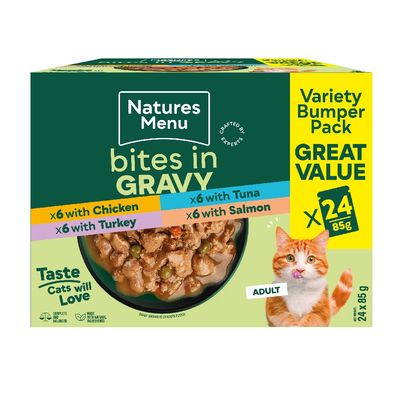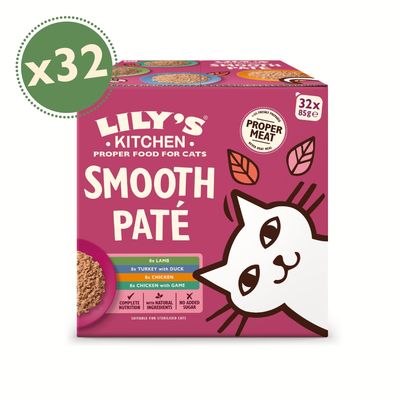Wet Cat Food - Cans, Pouches and Trays
MjAM MjAM Pure Meat Pleasure Mixed Pack 6 x 400g
Mixed Pack (3 varieties)
Feringa Cat Soup 12 x 70g
Chicken
MjAMjAM Pure Meat Pleasure 6 x 400g
Juicy Pure Chicken
Catessy Chunks in Sauce
12 x 100g
Natures Menu Bites in Gravy Mixed Pack
24 x 85g
Lily's Kitchen Smooth Paté Multipack
32 x 85g
MjAMjAM Pure Meat Pouches 12 x 125g
Pure Turkey
MjAMjAM Pure 6 x 200 g
delicious pure beef
animonda Carny Kitten Pouch 12 x 85g
Beef, Veal & Chicken
MjAMjAM in Sauce 6 x 185g
Chicken with Steamed Squash
MjAMjAM Duo 6 x 200g
Duck & Chicken
Concept for Life Sterilised Cats – in Gravy
12 x 85g
Sheba Nature's Collection Pouches 12 x 85g
Mixed Selection in Gravy
MjAMjAM Duo 6 x 200g
Beef & Turkey
MjAMjAM Pure Meat Pleasure 6 x 400g
Delicious Pure Beef
MAC's Cat 6 x 800g
Turkey, Beef & Blueberries
Smilla Saver Pack 20 x 400g
Salmon
Lily’s Kitchen Tasty Cuts in Gravy Chicken
24 x 85g
MjAMjAM 6 x 400g
Culinary Venison & Turkey with Fresh Cranberries
Sanabelle All Meat 6 x 180g
Goose & chicken
MjAMjAM Duo 6 x 400g
Juicy Chicken & Rabbit with Steamed Pumpkin
Concept for Life Maine Coon Adult - in Ragout
12 x 85g
Scrumbles Classic Pâté Selection Variety Pack Wet Cat Food
6 x 80g
thrive Complete Adult - Tuna with Vegetables
6 x 75g
How does wet cat food compare to dry food?
Cats naturally have a low thirst drive, so some owners choose wet food to help increase fluid intake as part of a balanced diet. Here's a comparison with dry cat food to help guide your choice:
| Feature | Moisture content |
|---|---|
| Wet cat food | High - can help encourage fluid intake |
| Dry cat food | Low - ensure fresh water is always available |
| Feature | Texture |
| Wet cat food | Soft - often preferred by kittens, older cats, or fussy eaters |
| Dry cat food | Crunchy - some owners choose for oral care routines |
| Feature | Protein levels |
| Wet cat food | Often high in animal protein |
| Dry cat food | May include more grains or plant-based protein |
| Feature | Shelf life (after opening) |
| Wet cat food | Shorter - store in the fridge and use quickly |
| Dry cat food | Longer - often resealable and easy to store |
| Feature | Convenience |
| Wet cat food | Single-serve options available (e.g., pouches, trays) |
| Dry cat food | Bulk-buy options available, often less sticky/messy |
| Feature | Calorie content |
| Wet cat food | Typically lower per gram |
| Dry cat food | More calorie-dense |
Feature | Wet cat food | Dry cat food |
|---|---|---|
Moisture content | High - can help encourage fluid intake | Low - ensure fresh water is always available |
Texture | Soft - often preferred by kittens, older cats, or fussy eaters | Crunchy - some owners choose for oral care routines |
Protein levels | Often high in animal protein | May include more grains or plant-based protein |
Shelf life (after opening) | Shorter - store in the fridge and use quickly | Longer - often resealable and easy to store |
Convenience | Single-serve options available (e.g., pouches, trays) | Bulk-buy options available, often less sticky/messy |
Calorie content | Typically lower per gram | More calorie-dense |
Tip: For cats with dietary sensitivities or health concerns, specialist cat food and supplements may be a suitable alternative. Remember, always consult your vet before making any changes.
How does wet cat food compare to dry food?
Cats naturally have a low thirst drive, so some owners choose wet food to help increase fluid intake as part of a balanced diet. Here's a comparison with dry cat food to help guide your choice:
| Feature | Moisture content |
|---|---|
| Wet cat food | High - can help encourage fluid intake |
| Dry cat food | Low - ensure fresh water is always available |
| Feature | Texture |
| Wet cat food | Soft - often preferred by kittens, older cats, or fussy eaters |
| Dry cat food | Crunchy - some owners choose for oral care routines |
| Feature | Protein levels |
| Wet cat food | Often high in animal protein |
| Dry cat food | May include more grains or plant-based protein |
| Feature | Shelf life (after opening) |
| Wet cat food | Shorter - store in the fridge and use quickly |
| Dry cat food | Longer - often resealable and easy to store |
| Feature | Convenience |
| Wet cat food | Single-serve options available (e.g., pouches, trays) |
| Dry cat food | Bulk-buy options available, often less sticky/messy |
| Feature | Calorie content |
| Wet cat food | Typically lower per gram |
| Dry cat food | More calorie-dense |
Feature | Wet cat food | Dry cat food |
|---|---|---|
Moisture content | High - can help encourage fluid intake | Low - ensure fresh water is always available |
Texture | Soft - often preferred by kittens, older cats, or fussy eaters | Crunchy - some owners choose for oral care routines |
Protein levels | Often high in animal protein | May include more grains or plant-based protein |
Shelf life (after opening) | Shorter - store in the fridge and use quickly | Longer - often resealable and easy to store |
Convenience | Single-serve options available (e.g., pouches, trays) | Bulk-buy options available, often less sticky/messy |
Calorie content | Typically lower per gram | More calorie-dense |
Tip: For cats with dietary sensitivities or health concerns, specialist cat food and supplements may be a suitable alternative. Remember, always consult your vet before making any changes.
How do I choose between wet cat food cans, pouches, and trays?
Unsure whether canned cat food, cat food pouches, or trays are right for your cat? Here’s a quick guide, as each format offers unique advantages:
- Cat wet food cans: Often more affordable and available in larger portions with recyclable packaging.
- Cat food pouches: Smaller (and so easier to store) with mess-free portions.
- Wet cat food in trays: Ideal for travel or feeding on the go, as cats can eat directly from the tray.
Did you know? Indoor cats often benefit from carefully selected diets, as their activity levels differ from outdoor cats.
How do I choose between wet cat food cans, pouches, and trays?
Unsure whether canned cat food, cat food pouches, or trays are right for your cat? Here’s a quick guide, as each format offers unique advantages:
- Cat wet food cans: Often more affordable and available in larger portions with recyclable packaging.
- Cat food pouches: Smaller (and so easier to store) with mess-free portions.
- Wet cat food in trays: Ideal for travel or feeding on the go, as cats can eat directly from the tray.
Did you know? Indoor cats often benefit from carefully selected diets, as their activity levels differ from outdoor cats.
What other features should I look for in wet cat food?
From dietary needs to flavour preferences and life stage suitability, a few key features can make the difference in finding the right cat food. Here’s what to keep in mind:
- Life stage formulas: Look for wet kitten food, adult recipes, or senior formulas based on your cat's age.
- Popular dietary needs: Options include grain-free and hypoallergenic recipes, high-meat content, and natural cat food.
- Texture preferences: Choose from mousse, pâté, chunks in gravy, or jelly – different textures can please picky eaters or may better match your cat’s dietary preferences or sensitivities.
- Flavour favourites: Popular flavours include chicken, tuna, salmon, turkey, and lamb. You can rotate or stick with your cat’s favourite.
- Trusted brands: Shop favourites like Felix, Sheba, Whiskas, Applaws, Encore, Royal Canin, Purina, IAMS.
Tip: Want to support your cat’s hydration and mealtime routine? Explore our cat water fountains and automatic cat feeders.
What other features should I look for in wet cat food?
From dietary needs to flavour preferences and life stage suitability, a few key features can make the difference in finding the right cat food. Here’s what to keep in mind:
- Life stage formulas: Look for wet kitten food, adult recipes, or senior formulas based on your cat's age.
- Popular dietary needs: Options include grain-free and hypoallergenic recipes, high-meat content, and natural cat food.
- Texture preferences: Choose from mousse, pâté, chunks in gravy, or jelly – different textures can please picky eaters or may better match your cat’s dietary preferences or sensitivities.
- Flavour favourites: Popular flavours include chicken, tuna, salmon, turkey, and lamb. You can rotate or stick with your cat’s favourite.
- Trusted brands: Shop favourites like Felix, Sheba, Whiskas, Applaws, Encore, Royal Canin, Purina, IAMS.
Tip: Want to support your cat’s hydration and mealtime routine? Explore our cat water fountains and automatic cat feeders.
Can I mix wet cat food and dry food?
Yes, this is called mixed feeding. It’s popular because it combines the moisture of wet food with the crunch of dry food, offering both flavour and texture variety. Just be sure to adjust portion sizes accordingly.
Can I mix wet cat food and dry food?
Yes, this is called mixed feeding. It’s popular because it combines the moisture of wet food with the crunch of dry food, offering both flavour and texture variety. Just be sure to adjust portion sizes accordingly.
Is wet cat food better than dry food?
Both types have their benefits. Wet food is high in moisture and offers variety, while dry food is convenient and can encourage chewing. Many cat owners choose a combination of both.
Is wet cat food better than dry food?
Both types have their benefits. Wet food is high in moisture and offers variety, while dry food is convenient and can encourage chewing. Many cat owners choose a combination of both.
What should I do if my cat won’t eat the new wet cat food?
Try warming it slightly to enhance the aroma or switching from pâté to chunks in jelly. Introduce changes gradually over 5–7 days. If your cat continues to refuse new food, try a different brand or texture, or consult your vet.
What should I do if my cat won’t eat the new wet cat food?
Try warming it slightly to enhance the aroma or switching from pâté to chunks in jelly. Introduce changes gradually over 5–7 days. If your cat continues to refuse new food, try a different brand or texture, or consult your vet.

























